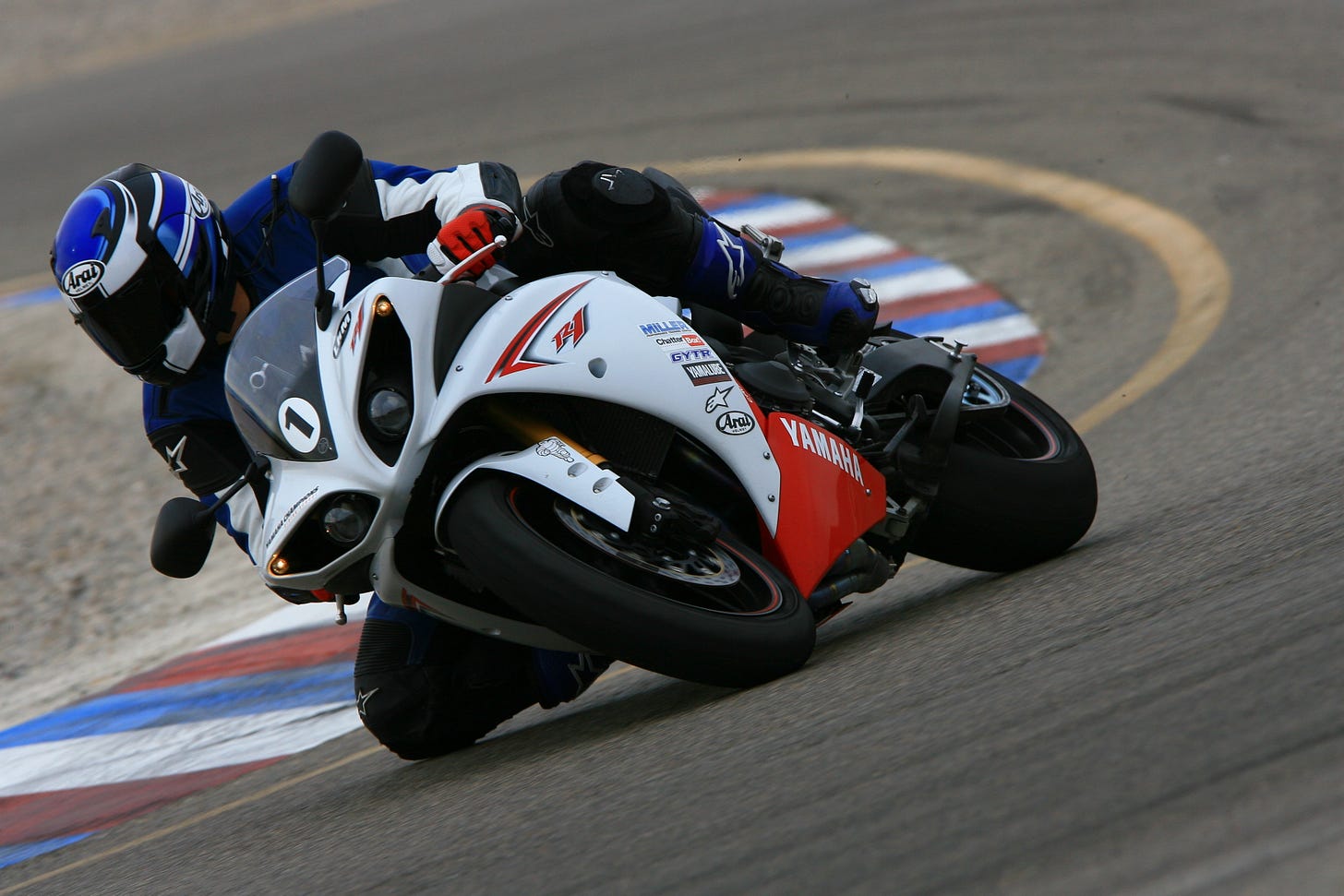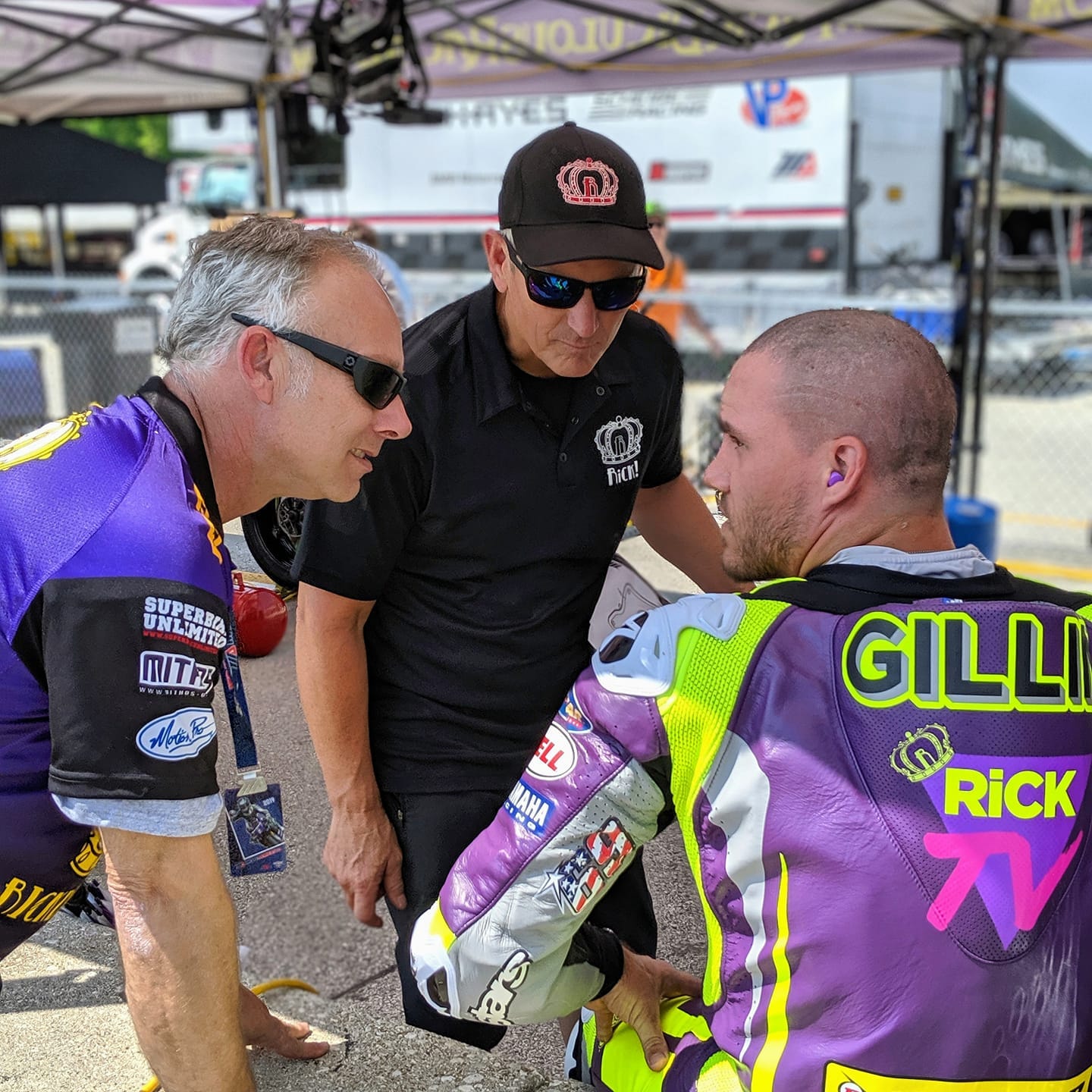[THE DEBRIEF] WHEN IS IT TIME TO ADDRESS SETUP?
Do you really need new suspension, or should you be working on yourself? Here's how to identify whether certain issues come down to you or your vehicle, and when it's time to look at setup
On-track improvement, whether achieving better lap times, enhancing precision, or maximizing enjoyment, comes down to a dynamic interplay between you and your machine. While vehicle setup is a crucial part of this equation, it only makes a real difference once you have achieved basic competency in the fundamentals. Focusing on setup too early is often a waste of effort and a crutch for covering up skill deficiencies. It’s all too easy to get swept up in the rollercoaster of incremental adjustments — but does that extra turn of preload or click of compression really matter if you’re still braking 200 feet too early? In this post, I want to explore the right approach to diagnosing whether the track improvement you want is a matter of developing your technique or working on your vehicle, with guidelines to assess your performance and build a feedback loop as you start adjusting your riding/driving and/or setup.
WHERE DO I START?
The first thing you need is to gather clean, objective data. Missed apexes or inconsistent brake release points aren’t reliable indicators. True clarity comes from well-established fundamentals, which provide the accuracy and structured feedback necessary to pinpoint when something is off. Gathering clean data starts with answering these questions:
Can you run a single lap hitting all your apexes?
Can you run multiple laps within 1 second, with no major variability due to driving/riding errors?
How far off the lap record for your vehicle are you?
Is the issue consistently happening in just one corner or in multiple corners?
Can a professional go faster with your current setup?
Where is the majority of your brainspace?
Are your current settings in an acceptable window?
Do you understand how your inputs (throttle, brakes, steering) affect the vehicle’s behavior?
Are you controlling your vehicle, or is it controlling you?
The philosophy behind the Order of the Sport is unambiguous on the point that technique always comes first. Addressing vehicle setup before you’ve mastered the basics often leads to frustration and wasted time. Without solid fundamentals, it’s easy to misdiagnose technique problems as setup problems, and no amount of setup changes will fix technique problems. So, as tempting as it is to tweak your machine, don’t let it distract you from improving your technique. A great driver or rider can adapt to almost any setup and deliver consistent laps even with a less-than-ideal setup.
If, however, your performance is consistent, and you have valid answers to the above questions, it might be time to look at setup adjustments.
IF YOU NEED TO MAKE A CHANGE, FIRST DETERMINE WHAT IT SHOULD BE
When your laptimes plateau despite consistency in performance, deciding on next steps involves determining whether to focus on technique or setup. This requires collecting information to identify the limiting factor(s), including both subjective (e.g., rider/driver feedback) and objective measures (e.g., data acquisition software) to pinpoint whether the issue lies in your technique or vehicle setup.
The goal is to assess whether trying something different impacts performance positively or negatively. Have a tester mindset: even unsuccessful attempts provide valuable insight by clarifying what works — experimentation is the key to discovery. For example, opening up a turn might fail if it causes missed apexes, while focusing on exits could improve exit RPMs and laptimes.
Is it me? The purpose of this question is to determine whether more potential exists within the current setup to improve your skills. Here are a few things to try:
Work on better exits.
Try slightly different lines.
Experiment with earlier or later slow points.
Remove weight from your hands at the slow point.
If equipped with vehicle electronics, try different electronic engagement points.
Is it my vehicle? The focus here is on specific segments, such as corner entry, corner exit, or direction changes. Before we start trying new things, though, we must ask ourselves:
Is there consistent feedback? Does the car or bike behave the same way through corners or braking zones, regardless of technique adjustments?
Have you explored all reasonable driver/rider changes and still hit a plateau?
Are mechanical limits clearly affecting performance, like suspension bottoming out or incorrect gearing for corner exits?
Are you feeling the vehicle’s limits before your own?
If the answer to most of the above questions is ‘no’, that tells you that you need to work on your driving/riding fundamentals first. Here’s what to try:
Use the controls with more force until you get feedback.
Use the controls with less initial input to see if more force can be applied later in the application and if there is positive or negative response.
Try different gears.
Try different shift points.
If equipped with vehicle electronics, try different electronic engagement points.
Work within your feel references to identify changes to the vehicle’s behavior.
TIME TO DOWNLOAD
Once you have experimented with different approaches to diagnose the problem and determine if it comes down to your technique or your vehicle, it’s time to build a systematic evaluation process to avoid the rabbit hole of infinite adjusting.
Feedback first: Write everything down. Use a post-session download form to record your thoughts (you can find samples here).
Clearly articulate/identify how the vehicle feels in different sections of the track (e.g., “the front feels vague at brake release on entry” or “the rear slides at initial throttle input on exit”).
Use precise language to describe what the vehicle is doing (not just “it feels weird”).
Be sure you’ve ruled out driver/rider error or inconsistent inputs.
Avoid making wholesale changes to address an issue in a single corner.
Use consistent references.
Reconcile subjective feel with objective measurements.
Data second: Is what you are experiencing on track verifiable with data? Use telemetry, lap-time analysis, or video feedback to pinpoint specific issues.
Consult experts: Collaborate with a coach, engineer, or trusted peer and avoid inexperienced opinions.
Look for the smoking gun: While there might be multiple issues, pinpoint the one most important issue that is holding you back and focus on that first.
Refer to similar references: Compare your data (whether rider/driver technique or setup) to objective reference data from an expert or a professional.
WHAT TO DO WHEN IT’S YOU
If you find that it’s your technique that needs work, the Order of the Sport provides a step-by-step roadmap to mastering motorsports fundamentals, creating a foundation for consistency and feedback. (Re)familiarize yourself with the six fundamentals:
Vehicle Placement: Are you consistently placing your car or bike in the optimal spot on the track? Are you taking advantage of what each corner offers?
Vision/Focus: Do you have defined reference points? Is your eye timing correct? Are you focused? Are you able to apply the correct technique proactively?
Motor Controls: Are your inputs precise and deliberate, matching your environment and the demands of the track?
Brake Adjustability: Can you modulate braking pressure to maximize speed control, steering, and entry speed?
Turn-in Point/Turn-in Rate: Are you entering corners at the right point and speed and hitting your apexes correctly?
Body Position/Body Timing (for riders): Is your body movement deliberate and the timing synchronized with the corner? Is there weight on your hands?
Attempting setup changes before mastering these fundamentals often leads to misdiagnosing problems or inconsistent feedback.
WHAT TO DO WHEN IT’S THE VEHICLE: HOW TO APPROACH SETUP CHANGES
Record your current setup: Before you change anything, record your current setup so you know where you started.
Know your operating envelope: Whether stock or modified, your vehicle has a known best operating window; find out what that is and compare it to your current settings.
One change at a time: Even if you identify multiple issues, change only one thing at a time to isolate the effect and avoid confusion.
Download after each run: I can’t stress enough how important this step is. Record both your subjective impressions and objective measurements.
Make big swings first: In the beginning, you may not feel small changes, so start with a change that’s big enough to feel and work backwards from there.
Reconcile changes with data afterwards: Your subjective impressions can’t always be trusted; use data to verify if a change has worked.
Not familiar with which changes accomplish what? Test them: “The best you know is the best you have ridden or driven.” If you’re not familiar with how certain aspects of a setting work, set time aside to try them in extreme positions (e.g., try full compression or minimum compression to see what happens).
Don’t be afraid to retest a setting: Going back to a previous setting is always a good way to see if you are making progress and to reexperience a prior setting for comparison.
Changes based on your style: Don’t get stuck using settings you overheard someone else mention at the morning briefing. Use your own personal feedback loop to determine what’s best for you.
Setups are ever evolving based on changes to your vehicle and your own development: Your vehicle needs to change as you develop and your level of application and technique change.
Changing conditions: Different weather, changing track conditions, worn tires, etc. all play a part in how your vehicle reacts; take that into consideration when making decisions on setup.
CONCLUSION
Working on setup only after developing proficient fundamentals is key to distinguishing between mechanical and skill-related limits. The relationship between your technique and your machine is symbiotic: great technique can adapt to poor setups, while a refined setup can temporarily mask deficiencies in technique, but will never help you become a better rider or driver and improve your track performance over the long term. Peak performance in motorsports comes from developing expert technique in the first place, and only using setup to maximize and amplify that technique.
About Ken Hill
Ken Hill is considered the top motorcycle riding coach in the U.S. He bought his first motorcycle at age 30 and began road racing the very same year. Despite the late start, Ken went on to set track records and win class championships before making his professional debut in the AMA Superbike class, where he finished in the top 10 at age 41. Ken’s passion for learning and, ultimately, bettering the sport, led him to retire from racing in 2007 and devote himself full-time to coaching. Learn more at khcoaching.com.




Another great post with so much good content. I have also found that there is a tendency to try to use setup changes to try to address comfort/commitment issues. “It just doesn’t feel right.” Working with a coach to address those areas before chasing setup adjustments can be critical.